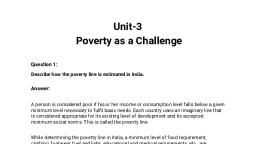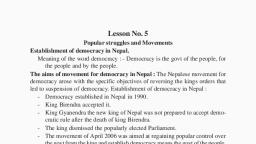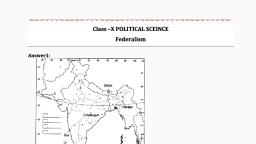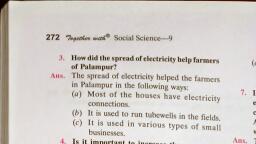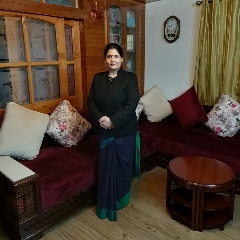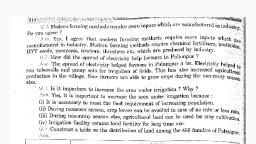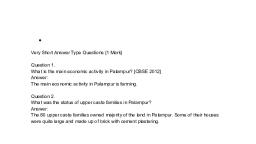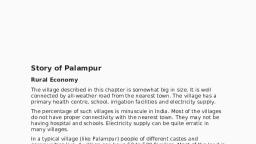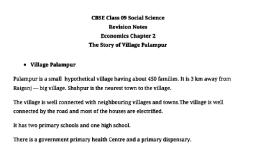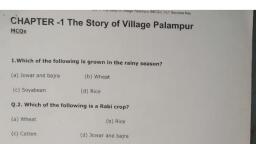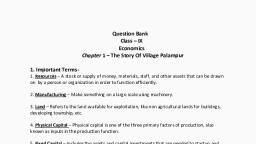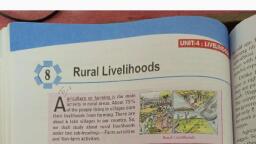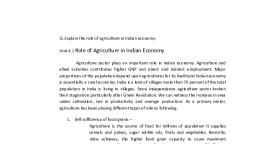Page 1 :
NCERT Solutions for Class 9 Social Science, Economics Unit 1, The Story of Village Palampur Class 9, Unit 1 The Story of Village Palampur Exercise Solutions, , Exercise : Solutions of Questions on Page Number : 14, Q1 :, Every village in India is surveyed once in ten years during the Census and some, of the details are presented in the following format. Fill up the following based on, information on Palampur. a. LOCATION:, b. TOTAL AREA OF THE VILLAGE:, a. LOCATION: Bulandshahar district, Western Uttar Pradesh
Page 2 :
b. TOTAL AREA OF THE VILLAGE: 226 hectares, , Q2 :, Modern farming methods require more inputs which are manufactured in, industry. Do you agree?, Answer :, Traditional farming methods involve the use of relatively low-yielding seeds, which, require less water for irrigation. Farmers following the traditional methods use cow dung, and other natural manure as fertilisers. All these elements are readily available with the, farmers. This makes them less dependent on industrial output., Modern farming methods, on the other hand, involve the use of high-yielding variety, seeds. These seeds require a combination of chemical fertilisers and pesticides,
Page 3 :
agricultural implements like tractors, and proper irrigation facilities like electric tube wells, to produce the best results. All these elements are manufactured in industries. Hence, it, would be right to say that modern farming methods make use of a greater number of, industrial outputs as compared to traditional farming methods., , Q3 :, How did the spread of electricity help farmers in Palampur?, Answer :, The spread of electricity in Palampur transformed the system of irrigation in the village., Persian wheels gave way to electric-run tube wells, which reduced the dependence of, the farmers upon rainfall, and enabled larger areas of land to be irrigated. By mid1970s,, the entire cultivated area of 200 hectares was irrigated. This improvement in irrigation, allowed farmers to grow three different crops in a year, thereby ensuring that the, cultivable land was being used for producing the maximum possible output., , Q4 :, Is it important to increase the area under irrigation? Why?, Answer :, Monsoons are by their very nature erratic and variable. So, farming cannot entirely, depend upon rains. A large portion of the cultivable land in India is not well irrigated and, is dependent entirely upon rains. As a result, when rains are late or are inadequate,, farmers incur much loss. The loss is more acutely experienced by the small farmers., Failure of rain means failure of crops and a total waste of efforts and resources, both for, the individual farmers and for the economy. To avoid such situations, it is important for, the entire cultivable area of the country to be brought under the protective shield of, proper irrigation facilities. A well-irrigated land produces greater output. The constant, availability of water for irrigation provides a sense of stability to the farmer, and also, encourages him to practise newer farming methods and patterns to maximise the, productivity from his land., , Q5 :, Construct a table on the distribution of land among the 450 families of Palampur., Answer :, Total area of land under cultivationin Palampur = 200 hectares, Q6 :
Page 4 :
Average area of land culti Number of fami Per cent of fami Per cent of land cultivated (approximat, vated, lies, lies, e values), Nil, , 150, , 33, , 0, , Less than 2 hectares per fa, mily, , 240, , 54, , 32, , More than 2 hectares per fa, mily, , 60, , 13, , 68, , Why are the wages for farm labourers in Palampur less than minimum wages?, Answer :, Though the minimum wage fixed by the government for a farm labourer is Rs 60 per, day, farm labourers in Palampur get paid much less, about 35 to 40 rupees a day. The, reason for this is the competition for work among the agricultural labourers in the village., Knowing that supply is much more than the demand, they themselves agree to work for, wages that are lower than minimum wages. The large farmers too exploit this condition, of excess supply, and force labourers to work for low wages. The use of modern, agricultural implements like tractors, threshers and harvesters also reduces the amount, of agricultural labour required. This further intensifies the competition among the, labourers looking for jobs., , Q7 :, In your region, talk to two labourers. Choose either farm labourers or labourers, working at construction sites. What wages do they get? Are they paid in cash or, kind? Do they get work regularly? Are they in debt?, Answer :, Attempt this question on your own., , Q8 :, Describe the work of a farmer with 1 hectare of land.
Page 5 :
Answer :, The situation of a farmer with 1 hectare of land is truly problematic. Since the land area, cultivated by him is small, the output is generally low. The produce is barely enough for, the survival of his family. To begin work on his farm, he needs to buy seeds and, fertilisers. For these, he needs sufficient capital, which is provided to him by the large, farmers, traders and moneylenders as loan. The loan comes with a high rate of interest, and often requires him to work in the lender's fields. He works on his field along with his, family members. Even after all their efforts of ploughing and sowing seeds, the output, depends upon the availability or non-availability of water for irrigation. If irrigation, facilities are not available, then the output is more or less dependent upon rainfall,, which is uncertain and erratic. Thus, even the low output is not something he can be, certain about. Hence, in order to make ends meet, and to repay his loans, he and his, family members have to work as farm labourers., After harvest, there is little or no surplus left as almost all the produce is either used for, his needs or for repaying his lenders. The lack of savings prevents him from adopting, better farming practises and improving the conditions on his farm and in his house. As, he is left with almost no working capital, his situation at the end of the day is still the, same. He is still in need of money to start working on his farm, and for this, he takes, more loans. Thus, he remains in the vicious circle of loans., , Q9 :, How do the medium and large farmers obtain capital for farming? How is it, different from the small farmers?, Answer :, Medium and large farmersretain a part of their produce and sell the surplus in the, market. This provides them with the required capital for farming. Most of them even use, these earnings to provide loans to small farmers. By charging high rates of interest on, these loans, they succeed in furthering their earnings. Thus, medium and large farmers, have ready capital with them from one agricultural season to the next., The situation of small farmers is in stark contrast. They begin an agricultural season, with no working capital and end the season on more or less the same note. To begin, working on their farms, they take loans at high rates of interest. Due to the small sizes, of their farms, their total production is small. Their produce is kept for their needs or for, repaying their lenders. As a result, they have no surplus to sell in the market, and thus,, have no savings.
Page 6 :
Q10 :, On what terms did Savita get a loan from Tejpal Singh? Would Savita's condition, be different if she could get a loan from the bank at a low rate of interest?, Answer :, Savita required money for buying seeds, fertilisers and pesticides, and water for, irrigation. She also needed money for repairing her farm instruments. So, she decided, to borrow money from Tejpal Singh, a large farmer in her village. Tejpal Singh agreed to, give the loan of Rs. 3000 at an interest rate of 24 per cent for four months. He also got, her to agree to work on his field during the harvest season for Rs. 35 a day. Knowing, that it was difficult for a small farmer like herself to get a loan, she agreed to these tough, conditions., If she could get a loan from a bank, then her situation would definitely have been, different. First of all, she would have got the loan at a reasonable rate of interest., Secondly, she would have been able to focus her entire attention on her farm. She, would also have been able to devote more time to the needs of her family members,, especially those of her three children., , Q11 :, Talk to some old residents in your region and write a short report on the changes, in irrigation and changes in production methods during the last 30 years., (Optional), Answer :, Attempt this question on your own., , Q12 :, What are the non-farm production activities taking place in your region? Make a, short list., Answer :, Attempt this question on your own., , Q13 :, What can be done so that more non-farm production activities can be started in, villages?, Answer :
Page 7 :
Three things that need to be done to encourage non-farm production activities in, villages:, (i), The government should set up schemes whereby landless labourers and small, farmers are able to get cheap loans to start small individual/community businesses., (ii), In addition to financial assistance, the government should set up rural workshops, to enable the villagers to build on their skill levels., (iii), The government should also work towards improving the infrastructure of villages, so that the rural parts of the country are well connected to the urban areas.

